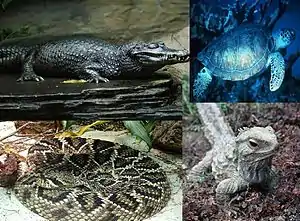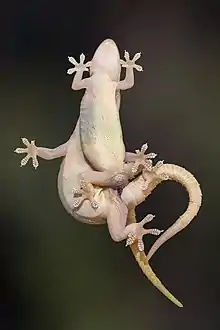တွားသွားသတ္တဝါ
တွားသွားသတ္တဝါဆိုသည်မှာ ရက်ပတီလီးယား (Reptilia) မျိုးပေါင်းတွင် ပါဝင်သော သတ္တဝါများဖြစ်သည်။[1] သူတို့၏ ထင်ရှားသော လက္ခဏာများမှာ အသက်ရှူခြင်း၊ အခွံပါသော ဥများကို ဥခြင်း (အချို့သော မြွေများမှာ အရှင်မွေးကြသည်။) နှင့် အကြေးကွက်များ နှင့် အကြေးခွံများ ပါရှိသော အရေပြားများ ရှိကြခြင်း တို့ဖြစ်သည်။ တွားသွားသတ္တဝါများကို ပုံမှန်အားဖြင့် သွေးအေး သတ္တဝါများ ဟု ရှုမြင်ကြသည်။ သူတို့ကို ခြေလေးချောင်းရှိသော သို့ ခြေလေးချောင်းရှိသော မျိုးရိုးမှ ဆင်းသက်လာသော တက်ထရာပေါ့ဒ်ဟု ခေါ်ဝေါ်ကြသည်။ ယခုခေတ်တွင် တွားသွားသတ္တဝါများသည် အန္တာတိက တိုက်မှ လွဲ၍ တိုက် တိုင်း လိုလိုတွင် နေထိုင်ကြပြီး မျိုးစစ် ၄ ခု ခွဲခြားထားသည်။[2]
| Amniota |
| ||||||||||||||||||||||||||||||||||||||||||||||||||||||||||||||||||||||||||||||||||||||||||||||||||||||||||||||||||||||||||||||||||||||||||||||||
| တွားသွားသတ္တဝါ | |
|---|---|
 | |
| Clockwise from above left: Spectacled Caiman (Caiman crocodilus), Green Sea Turtle (Chelonia mydas), Tuatara (Sphenodon punctatus) and Eastern Diamondback Rattlesnake (Crotalus adamanteus). | |
| မျိုးရိုးခွဲခြားခြင်း | |
| Subgroups | |
|

ကိုးကား
- Sander, P. Martin (2012). "Reproduction in early amniotes". Science 337 (6096): 806–808. doi:. PMID 22904001. Bibcode: 2012Sci...337..806S.
- https://theconversation.com/climate-change-created-todays-large-crocodiles-121933





_(Varanus_griseus).png.webp)
